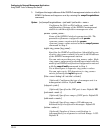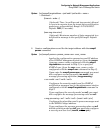
Configuring for Network Management Applications
Using SNMP Tools To Manage the Switch
For example, to configure a trap receiver in a community named "red-team"
with an IP address of 10.28.227.130 to receive only "critical" event log
messages, you can enter the following command:
ProCurve(config)# snmp-server host 10.28.227.130 red-team
critical
Notes To replace one community name with another for the same IP address, you
must first enter the no snmp-server host < community-name> <ipv4-address | ipv6-
address > command to delete the unwanted community name. Otherwise, if
you add a new community name with an IP address that is already used with
a different community name, two valid community name entries are created
for the same management station.
If you do not specify the event level ([<none | all | non-info | critical | debug>]),
the switch does not send event log messages as traps. However, "well-known"
traps and threshold traps (if configured) are still sent.
Enabling SNMPv2c Informs
On a switch enabled for SNMPv2c, you can use the snmp-server host inform
command to send inform requests when certain events occur. When an SNMP
Manager receives an inform request, it can send an SNMP response back to
the sending agent on the switch to let the agent know that the inform request
reached its destination.
If the sending agent on the switch does not receive an SNMP response back
from the SNMP Manager within the timeout period, the inform request may
be resent, based on the retry count value.
When you enable SNMPv2c inform requests to be sent, you must specify the
IP address and community name of the management station that will receive
the inform notification.
Syntax: [no] snmp-server host <ipv4-addr | ipv6-addr> <community name>
inform [retries <count>] [timeout <interval>]]
Enables (or disables) the inform option for SNMPv2c on the
switch and allows you to configure options for sending
SNMP inform requests.
retries: Maximum number of times to resend an inform
request if no SNMP response is received. Default: 3
timeout: Number of seconds to wait for an acknowledgement
before resending the inform request. Default: 15 seconds
13-21


















